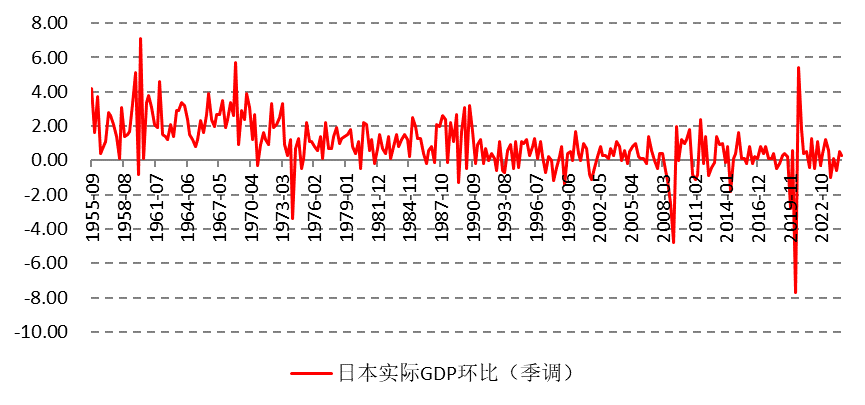After Shigeru Ishiba was re-elected as Prime Minister of Japan on November 11th, the Japanese economy still faces several major challenges, among which it is particularly important to seek a balance between inflation and economic growth.
Recently, the Japanese stock market has fallen into a range-bound trend, and the yen exchange rate no longer depreciates unilaterally. By next year, the direction of Shigeru Ishiba's economic stimulus is to increase residents' income and fight inflation through subsidies, but the effect remains to be seen.
The tariff increase imposed by Trump's new administration may have an additional impact on the Japanese economy, and the sustainability of Japan's debt is also problematic. Therefore, the Japanese stock market has not yet ushered in a new upward driver. rate hike may cause the yen exchange rate to appreciate in stages, but the sustainability remains to be seen.
Japan's economic resilience is weakening
Japan raised its third-quarter GDP growth due to upward revision of capital investment and export data. According to the latest revised data released by the Cabinet Office of Japan, Japan's GDP in the third quarter increased by 1.2% at an annual rate, higher than the initial value of 0.9%; After price adjustment, Japan's GDP increased by 0.3% quarter-on-quarter, higher than the initial value of 0.2%.
The contribution rate of net exports to Japan's GDP is still negative. Exports of goods and services increased by 1.1% month-on-month in the third quarter and 1.5% in the second quarter, indicating that the pull of exports on the Japanese economy has weakened.
The prosperity of Japan's manufacturing industry is closely related to exports, and the decline in export growth means that the manufacturing industry is still in a state of contraction. Data show that Japan's manufacturing PMI fell to 49% in November, down 0.2 percentage points from the previous month. This is also the fifth consecutive month since July that it has been below 50 watershed.
Facing the balance of wage growth and inflation
Goldman Sachs pointed out in its 2025 Japan Economic Outlook report that Japan has crossed the key inflation threshold-a benign "wage-price spiral" has emerged. The author believes that the key to whether the Japanese economy will have a benign "wage-price spiral" in 2025 lies in the balance between wage growth and inflation.
Inflation rebounded significantly in November. On November 29, the Japanese government released data showing that Tokyo's CPI rose by 2.6% year-on-year in November, higher than the expected 2.2%. Tokyo's CPI (excluding fresh food) rose 2.2% year-on-year in November, 2% higher than expected, mainly due to the gradual reduction of energy subsidies.
Data show that in the case of a rebound in inflation, the growth rate of real disposable income excluding inflation in Japan's household sector is much lower than the nominal growth rate. The average monthly disposable income of Japanese families with two or more workers increased by 4.6% year-on-year in October, but it was still lower than the 12.1% increase after the end of the "spring fight" in June.
The impact of US tariff increases cannot be ignored
It is very likely that the Trump administration will impose tariffs on trading partners in 2025, which is expected to lead to a significant impact on Japan's exports, thus dragging down the growth of Japan's economy. The United States is the main export market for Japanese cars. According to data from the Japanese Ministry of Finance, the United States will be Japan's largest export destination in 2023. Automobiles and auto parts will account for one-third of Japan's exports. Japan exported 1.48 million vehicles to the United States, a year-on-year increase of 16%, accounting for Japan's auto exports. 34% of the share.
Research by Nomura Securities shows that if the United States imposes a 10% tariff on Japan, without taking into account the tariffs of Mexico and Canada, Subaru's operating profit will drop by 35% in fiscal year 2025, and Mazda, Mitsubishi and Nissan will drop by 33%, respectively. 21%, 13%.
Fiscal stimulus faces debt sustainability issues
On November 22nd, the Shigeru Ishiba government of Japan approved an economic stimulus plan of 39 trillion yen (about 250 billion US dollars). The Japanese government will arrange fiscal expenditures of 21.9 trillion yen through special budgets and supplementary budgets. Other sources of funds include private investment, etc.
According to Japanese media reports, the Japanese government intends to fund about half of the supplementary budget (or 6.7 trillion yen) by issuing new bonds, which has exacerbated people's concerns about Japan's fiscal situation. The leverage ratio of the government sector was 218% in the third quarter of 2024, peaking at 228% in the second quarter of 2022.
In 2025, Japan's debt will expand again under a new round of fiscal stimulus. If economic growth underperforms the speed of debt expansion, the government's proportion of GDP will rise again, affecting the sustainability of debt and leading to a decline in investors' confidence in yen assets, which can easily lead to the risk of selling yen assets.
To sum up, the author believes that the problem of Japan's aging population has not been solved.
By increasing the growth of wage income, we can cure the symptoms rather than the root cause. If the inflation growth exceeds the wage growth, then consumption may stall. Moreover, Japan has long faced the problem of excessive public debt, and semiconductor exports are facing competitive pressure from China and the United States.
The Japanese economy still faces multiple challenges. Investors can pay attention to the potential risk of CME group micro Nikkei index futures hedging, and the risk of USD/JPY futures hedging the depreciation of the yen.
$OSE Mini Nikkei 225 - main 2503(JMImain)$ $Japanese Yen - main 2412(JPYmain)$
$NQ100 Index Main 2412 (NQmain) $$SP500 Index Main 2412 (ESmain) $$Dow Jones Index Main 2412 (YMmain) $$Gold Main 2502 (GCmain) $$WTI Crude Oil Main 2501 (CLmain) $

Comments